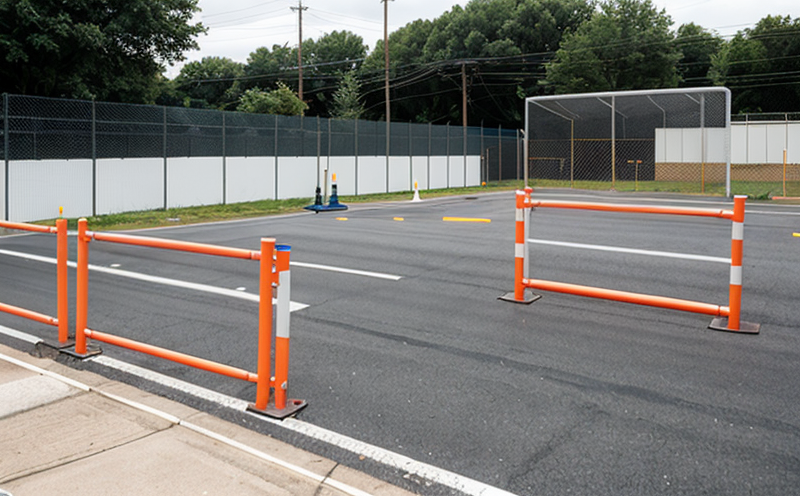CSA Z94.1 Helmet-Mounted Protective Barriers Testing
The CSA Z94.1 standard is a cornerstone in the design and evaluation of helmets and protective barriers intended to safeguard workers from head injuries caused by impacts, penetration, or other hazards. This comprehensive testing ensures that the equipment meets stringent safety requirements, providing assurance for both manufacturers and end-users.
Helmets with mounted protective shields are particularly critical in high-risk environments where workers face a higher likelihood of impact trauma. These helmets must not only protect against direct head impacts but also shield the wearer's visor or face shield from hazards such as flying debris, chemical splashes, or environmental elements. The CSA Z94.1 standard encompasses testing procedures to ensure that these helmets and barriers meet the highest safety standards.
The testing process involves a series of rigorous evaluations designed to simulate real-world scenarios where the helmet might be exposed to impact forces. This includes drop tests using various test heads, which are subjected to impacts from different directions and at varying heights. Additionally, penetration resistance tests assess the ability of the shield to withstand sharp objects or high-pressure air bursts.
For a helmet-mounted protective barrier to pass these stringent tests, it must demonstrate superior performance in both impact attenuation and penetration resistance. The testing apparatus used includes drop towers that simulate fall hazards, and high-velocity impactors designed to replicate real-world impacts. These devices are calibrated according to international standards such as ISO 12409:2005 for helmet testing.
The acceptance criteria for CSA Z94.1 are strictly defined, ensuring that only helmets meeting these standards can be considered safe for use in potentially hazardous environments. Compliance with this standard is crucial for both manufacturers and end-users, as it assures that the equipment meets regulatory requirements and provides a higher level of safety.
Understanding the real-world applications of CSA Z94.1 testing helps to appreciate its significance. In industries such as construction, manufacturing, and transportation, where workers face numerous hazards daily, compliance with this standard can save lives and prevent serious injuries. The data generated from these tests is crucial for continuous improvement in helmet design and safety features.
Through meticulous testing and evaluation, laboratories like ours ensure that helmets and protective barriers meet the highest safety standards set by CSA Z94.1. Our expertise lies in providing accurate, reliable test results that can be trusted to inform critical decisions about equipment safety and compliance.
Why It Matters
The significance of CSA Z94.1 helmet-mounted protective barriers testing cannot be overstated. In environments where workers are exposed to head injuries, such as construction sites or industrial facilities, the use of properly tested and certified helmets is essential. These helmets not only protect against direct impact but also shield the wearer from other hazards like flying debris or chemical splashes.
The impact attenuation test ensures that the helmet can absorb energy effectively during a fall or strike, significantly reducing the risk of head injury. Penetration resistance tests are equally important as they verify that the visor or face shield cannot be breached by sharp objects or high-pressure air bursts. This dual protection is critical in maintaining worker safety and compliance with regulatory standards.
The benefits of adhering to CSA Z94.1 extend beyond mere safety; they also contribute to organizational efficiency and productivity. By ensuring that the equipment meets stringent safety requirements, companies can avoid costly downtime due to workplace accidents or non-compliance penalties. Furthermore, adherence to these standards enhances a company's reputation as a leader in occupational health and safety.
- Reduces head injury risk: Ensures helmets meet impact attenuation and penetration resistance criteria.
- Enhances worker confidence: Provides peace of mind knowing the equipment is rigorously tested and certified.
- Avoids regulatory penalties: Ensures compliance with international standards, avoiding potential legal issues.
- Improves operational efficiency: Reduces downtime due to accidents or non-compliance issues.
- Enhances reputation: Demonstrates commitment to worker safety and compliance with industry best practices.
In summary, the importance of CSA Z94.1 testing lies in its role as a critical component of occupational health and safety measures. By ensuring that helmets meet these stringent standards, companies can significantly enhance their workers' safety while also promoting operational efficiency and regulatory compliance.
Benefits
The benefits of CSA Z94.1 helmet-mounted protective barrier testing are multifaceted, encompassing both direct and indirect advantages for all stakeholders involved in the safety and protection of workers. Here’s a detailed look at what these benefits entail:
- Enhanced Safety: By ensuring that helmets meet stringent impact attenuation and penetration resistance criteria, this testing significantly reduces the risk of head injuries.
- Increased Worker Confidence: Knowing the equipment has passed rigorous tests instills a sense of security among workers, leading to higher morale and productivity.
- Regulatory Compliance: Adherence to international standards ensures that companies are compliant with regulatory requirements, thereby avoiding potential legal issues.
- Operational Efficiency: By minimizing the risk of accidents, these tests help reduce downtime due to workplace injuries or non-compliance penalties.
- Better Reputation: Demonstrating a commitment to worker safety and compliance enhances a company's reputation as an industry leader in occupational health and safety.
- Improved Product Quality: Rigorous testing ensures that the final product is of high quality, meeting or exceeding international standards.
- Cost Savings: While initial costs may seem high, the long-term savings from avoiding accidents and associated penalties make this investment worthwhile.
- Environmental Impact Reduction: By ensuring safer working conditions, these helmets contribute to a healthier environment by reducing the need for medical interventions and emergency responses.
In conclusion, CSA Z94.1 helmet-mounted protective barrier testing is not just about meeting standards; it’s about fostering a culture of safety, compliance, and excellence that benefits everyone involved in occupational health and safety.





